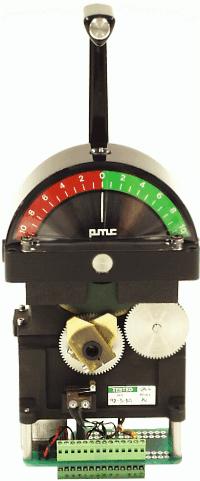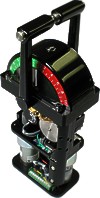
Type 5040-1000 MCH-ES

Type 5040-2000 MCH-ES2
Electric Shaft Remote Control Head
 Type 5040-1000 MCH-ES |
 Type 5040-2000 MCH-ES2 |
Dependable Precise Control
MCH-ES control heads provide remote control for a wide range of marine and industrial applications.
Illumination
Optional illumination is available with a variety of scales.
Watertight
Completely watertight design with corrosion resistant materials allows installation in outdoor stations.
Versatile
Modular construction allows many potentiometer, scale, switch, handle and servomotor options. Standard control lever movement is 140°.
Servo Positioning
Motor driven control lever servo positioning system provides accurate responsive follow-up.
Control Transfer
Transfer between stations is activated manually with a pushbutton.
Bumpless Transfer
Control transfer between stations is always smooth because all levers are continuously aligned with the controlling station.
Options
Many options and support products are available which allow numerous system configurations.
Description:
General
The PMC electric shaft control system is an all electric alternative to the use of mechanical shafting for interconnecting control levers on a ship.
Electric shaft controls can be installed at any station where power and wiring are available. They offer continual real time display, ant all stations, of the position of the levers at the controlling station. Because all levers are continually aligned, control transfer between stations is smooth and "bumpless".
A basic electric shaft control system consists primarily of three PMC products: two or more MCH-ES control heads, one servo control unit for each control head and one control transfer unit for each system.
Control Head
The Type MCH-ES control head is a single or dual lever, manual position transmitter consisting of a high torque servomotor with worm gear reducer and friction clutch, a position feedback potentiometer, two end-travel limit switches, a colored display scale and internal illumination. The illuminated internal pointer provides visible indication at night of the lever position. The control head provides positive, firm lever response with excellent tactile feedback and smooth movement into any selected handle position. Optional potentiometers may be added for driving remote actuators, data loggers, etc.
Servo Control Unit
The servo control unit (SCU) is a track-mounted, printed circuit board incorporating a high gain, optimally damped, servo amplifier which is used for driving the control head servomotor. It includes an auto-transfer section so that a change in the position potentiometer status due to a lever movement generates a transfer signal to the control transfer unit. When its station is in command, the SCU disables the servomotor and generates a highly reliable 4-20 mA current loop proportional to the command lever position. This is sent to all other stations in the electric shaft loop. When not in command, the SCU accepts the current signal from the commanding station, then compares it with its own control lever position and drives the lever into alignment.
The servo control unit includes power input reverse and over-voltage protection circuits to guard against incorrect connections or voltage levels. Also extensive filtering is employed at the power supply input to prevent RFI or EMI from affecting the operation of the electric shaft control circuitry and to prevent the electric shaft system from emitting EMI radiation. The servomotor output drive transistors are thermally limited and current limited. The unit shuts down automatically on potentiometer failure. On current loop failure the system shuts down automatically, allowing manual operation from the engine room station. Many other shutdown modes are included for additional safety. A volt-free contact is provided for power failure and non alarms.
Control Transfer Unit
The control transfer unit (CTU) is a track mounted printed circuit board. It provides contention-free control logic so that only one station can be in command at any instant. Transfer signals are provided by normal open remote push buttons or from the SCU logic. When an input is provided, the CTU generates on output signal which transfers control to the correct station. Transfer operates on a "first-in, last out" basis. Up to eight station may be connected and station No. 1 is designated as the master. A command request from the master station will override any other request. On power-up, station No. 1 automatically receives control.
The CTU includes a disable input terminal. When activated, it removes control from all stations. Internal memory retains input status while the disable is active, so that control returns correctly when the disable signal is removed. Power input reverses and over-voltage circuits are also provided to guard against incorrect connections or voltage levels.
Dimensions above Console (without gasket)
| Width: | 112 mm (130mm two handles) |
| Length: | 156 mm |
| Height: | 157 mm (197 long handle) |
Typical Installations
Ladoga 104 is one of eight 82.5 m cargo vessels built for Northwest River Shipping Company in St. Petersburg. They each are equipped with Type 5040 MCH-ES electric shaft control heads and Type 5022 RCH-VAA pneumatic control heads.
| Home | PRIME MOVER
CONTROLS INC. 3600 GILMORE WAY, BURNABY B.C. CANADA V5G 4R8 TEL (604) 433-4644 FAX (604) 433-5570 email:info@pmc-controls.com |